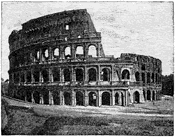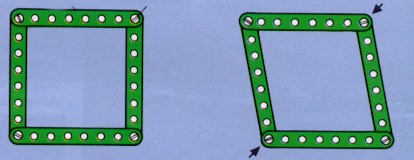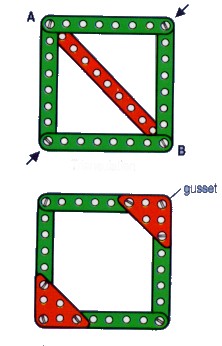 Structures
Structures  Structures
Structures
The Design of Frame Structures
From your investigations into structures, you will have noticed a similarity between the structures, as well as obvious differences. One of the similarities you should have noticed is the obvious triangular pattern within the frame.
Making Structures Rigid
If you were on a moving train or boat, how would you stand to keep your balance? If you stood with your legs apart, you'd be turning yourself into a human triangle. Triangles are stable and strong. That is why builders and architects use them for lightweight bridges and towers.
Try this. Join four strips of cardboard together at the corners with a butterfly clip. A frame structure can also be made rigid by the use of gusset plates.
Look around you. Find examples of triangles that make things strong. You probably didn't think of the hidden triangle in a slice of green pepper. Since the green pepper is almost hollow inside, it's much lighter than a solid fruit of the same size, such as an orange. The green pepper keeps its firm, rounded shape because of its inner triangular ribs.
How about a shelf support, an ironing board, a window fastening holding a window open, a bicycle frame, a deck chair, a music stand, a gate or the timbers in the roof? Communications and electricity towers are excellent examples of triangular structures as is the Eiffel Tower. Before he designed the Eiffel Tower for the Paris exhibition of 1889, Gustave Eiffel had already built many iron viaducts and bridges and had learned a lot about using triangulated structures to resist the blows of wind and water. Nevertheless, for his tower, he didn't leave anything to change. Before starting the building, he made over 5000 drawings of all parts of the tower, drawings that called for 15 000 structural members and 2 500 000 rivet holes. A modern use of the triangle is seen in the geodesic domes invented by Buckminster Fuller for covering sports arenas, or on a smaller scale as greenhouses and climbing frames. Microlight planes and the undercarriage of the lunar space module use the rigidity of the triangular structure.
Assignment:
Paper Bridge Take a piece of paper and hold it at the corners along one edge. See how it droops--it can't support its own weight. You need to make it stronger. You could glue some cardboard stiffeners along its length, but not for this experiment you can't. You can only use one piece of loose leaf paper.
You need to make the strongest bridge you can using:
Procedure:
Write up your experiment using proper lab write-up procedure and hand it in. It will become part of your design portfolio.
![]()

 Push on one of the corners. When forces are applied to the simple four-sided structure as shown here, it can be forced out of shape. Now add an extra bar (which is called a member when you are working with structures). Again, push on one of the corners. What do you notice?
Push on one of the corners. When forces are applied to the simple four-sided structure as shown here, it can be forced out of shape. Now add an extra bar (which is called a member when you are working with structures). Again, push on one of the corners. What do you notice?  The structure can no longer be forced out of shape, and is said to be rigid. Notice that the additional member has formed triangles in the structure. The effect is known as triangulation. The triangle is the most rigid frame structure. Engineers have known for a long time that whenever they need a light, strong, rigid structure they cannot do better than use a framework of triangles.
The structure can no longer be forced out of shape, and is said to be rigid. Notice that the additional member has formed triangles in the structure. The effect is known as triangulation. The triangle is the most rigid frame structure. Engineers have known for a long time that whenever they need a light, strong, rigid structure they cannot do better than use a framework of triangles.
| Notes and Assignments | Project Requirements
Project Overview | Design Process | Design Report | Design Portfolio |
Getting Started |